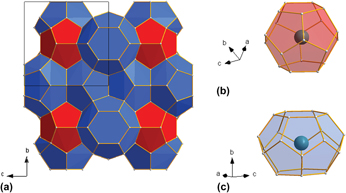Crossref Citations
This article has been cited by the following publications. This list is generated based on data provided by
Crossref.
Chan, Kwai S.
Miller, Michael A.
Liang, Wuwei
Ellis-Terrell, Carol
and
Chan, Candace K.
2017.
First principles and experimental studies of empty Si46 as anode materials for Li-ion batteries – CORRIGENDUM.
Journal of Materials Research,
Vol. 32,
Issue. 13,
p.
2628.
Zhao, Ran
Bobev, Svilen
Krishna, Lakshmi
Yang, Ting
Weller, J. Mark
Jing, Hangkun
and
Chan, Candace K.
2017.
Anodes for Lithium-Ion Batteries Based on Type I Silicon Clathrate Ba8Al16Si30 - Role of Processing on Surface Properties and Electrochemical Behavior.
ACS Applied Materials & Interfaces,
Vol. 9,
Issue. 47,
p.
41246.
González, I.
Sosa, A. N.
Trejo, A.
Calvino, M.
Miranda, A.
and
Cruz-Irisson, M.
2018.
Lithium effect on the electronic properties of porous silicon for energy storage applications: a DFT study.
Dalton Transactions,
Vol. 47,
Issue. 22,
p.
7505.
Dopilka, Andrew
Zhao, Ran
Weller, J. Mark
Bobev, Svilen
Peng, Xihong
and
Chan, Candace K.
2018.
Experimental and Computational Study of the Lithiation of Ba8AlyGe46–y Based Type I Germanium Clathrates.
ACS Applied Materials & Interfaces,
Vol. 10,
Issue. 44,
p.
37981.
Chan, Kwai
2018.
Hybrid Carbon-Based Clathrates for Energy Storage.
C,
Vol. 4,
Issue. 1,
p.
7.
Dopilka, Andrew
Peng, Xihong
and
Chan, Candace K.
2019.
Ab Initio Investigation of Li and Na Migration in Guest-Free, Type I Clathrates.
The Journal of Physical Chemistry C,
Vol. 123,
Issue. 37,
p.
22812.
Tai, Xia
Li, Xifei
Kakimov, Alibek
Li, Shiyu
Liu, Wen
Li, Jianwei
Xu, Jie
Li, Dejun
and
Sun, Xueliang
2019.
Optimized ALD-derived MgO coating layers enhancing silicon anode performance for lithium ion batteries.
Journal of Materials Research,
Vol. 34,
Issue. 14,
p.
2425.
Fix, Thomas
Vollondat, Romain
Ameur, Arechkik
Roques, Stéphane
Rehspringer, Jean-Luc
Chevalier, Céline
Muller, Dominique
and
Slaoui, Abdelilah
2020.
Silicon Clathrate Films for Photovoltaic Applications.
The Journal of Physical Chemistry C,
Vol. 124,
Issue. 28,
p.
14972.
Tarnev, Tsvetan
Wilde, Patrick
Dopilka, Andrew
Schuhmann, Wolfgang
Chan, Candace K.
and
Ventosa, Edgar
2020.
Surface Properties of Battery Materials Elucidated Using Scanning Electrochemical Microscopy: The Case of Type I Silicon Clathrate.
ChemElectroChem,
Vol. 7,
Issue. 3,
p.
665.
Fan, Linlin
Yang, Deren
and
Li, Dongsheng
2021.
A Review on Metastable Silicon Allotropes.
Materials,
Vol. 14,
Issue. 14,
p.
3964.
Vollondat, Romain
Roques, Stéphane
Chevalier, Céline
Bartringer, Jérémy
Rehspringer, Jean-Luc
Slaoui, Abdelilah
and
Fix, Thomas
2022.
Synthesis and characterization of silicon clathrates of type I Na8Si46 and type II NaxSi136 by thermal decomposition.
Journal of Alloys and Compounds,
Vol. 903,
Issue. ,
p.
163967.
Ghosh, Kowsik
Ovchinnikov, Alexander
Baitinger, Michael
Krnel, Mitja
Burkhardt, Ulrich
Grin, Yuri
and
Bobev, Svilen
2023.
Lithium metal atoms fill vacancies in the germanium network of a type-I clathrate: synthesis and structural characterization of Ba8Li5Ge41.
Dalton Transactions,
Vol. 52,
Issue. 30,
p.
10310.
Vollondat, Romain
Stoeffler, Daniel
Preziosi, Daniele
Roques, Stéphane
Slaoui, Abdelilah
and
Fix, Thomas
2023.
Tunability of silicon clathrate film properties by controlled guest-occupation of their cages.
The Journal of Chemical Physics,
Vol. 158,
Issue. 16,




